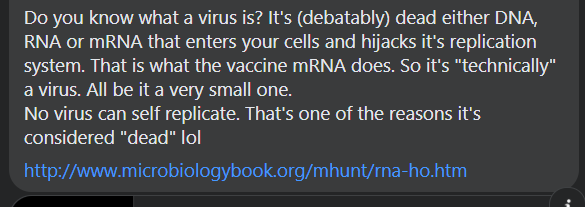Today I was told that the Pfizer-BioNTech vaccine (now approved for use in the US, UK, & Canada) is a virus (screencap at the bottom of this thread). It really isn’t, but I’ve seen this one several times & so I think it’s worth unpacking a little further. (You can also read about mRNA vaccines here, here, & here, for example.)
Let’s start with the vaccine. I’ve already written about its other constituents, but the bit that’s important immunologically is a short mRNA strand coding for part of the “spike” protein of SARS-Cov-2 (the part that acts as an antigen & elicits an immune response). This small piece of RNA carries information in a form that acts as a template for cells to construct the protein fragment, which is done by a process known as translation. As the writers of an article in The Conversation have said, “[t]his gives the immune system a preview of what the real virus looks like without causing disease.”
After someone’s received an injection of this particular vaccine, the mRNA molecules guide spike protein production inside the muscle cells, a process that lasts for a couple of days.
And that’s it. Cells don’t make more of the covid19-vaccine strand of mRNA, because it doesn’t carry the instructions to do that. It can’t infect other cells, and it cannot change your DNA. (It’s important to remember, too, that this is not brand-new technology; see also here & here.)
What about viruses?
Well, the description given by the commenter in the image below is basically correct. Viruses consist of genetic material, which may be DNA or RNA, enclosed in a protein coat which may in turn be surrounded by a fatty lipid membrane – this can be broken down by detergents, which is why proper handwashing is important as a defence against covid19 infection. (Strictly speaking, when outside the cell an assembled virus – genetic material in a protein coat – is known as a virion.)
Alone, they’re inert, but once inside a cell they can take over the cell’s processes and use them to make more viruses. (More specifically, to make more copies of the viral genome and more of the pieces that make up the viral coat, or capsule.) Once new viral particles have been assembled, they can break out of the host cell and go on to infect more cells (& more host organisms). In some instances – Human Immunodeficiency Virus is one – the viral genome includes the genetic sequence for an enzyme that allows the virus to ‘write’ its genes into the host cell’s DNA. These viruses are known as retroviruses.
It’s worth pointing out that a viral genome is relatively extensive when compared to the mRNA sequence used in this vaccine. Each virus particle’s nucleic acids contain instructions for replicating all of its DNA and for manufacturing the components of its enclosing capsule i.e. multiple genes are involved.
Thus the mRNA in Pfizer-BioNTech’s vaccine is not a virus – it contains no sequence beyond that for the spike protein; no ability to induce the cells to make more of it; no instructions for any capsule components; no ability to infect other cells. And no ability to manipulate your DNA, notwithstanding comments like this.
NB the subthread has subsequently been deleted by its originator. My short explanation of why the vaccine is not a virus was apparently not appropriate for wider consumption.

